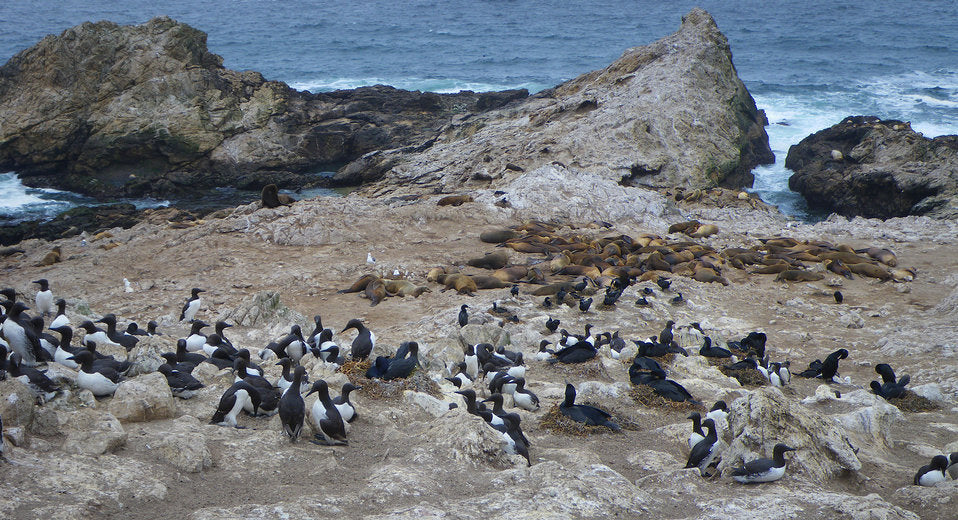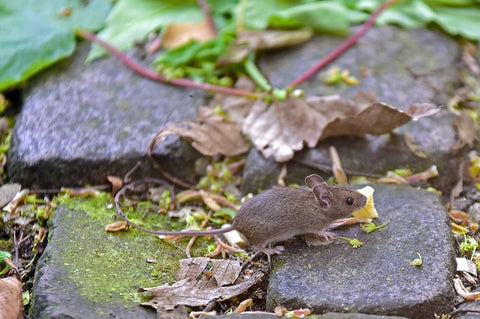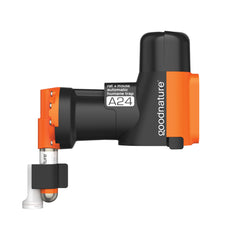
A brief history of the Farallon Islands
The Farallon Islands, collectively sometimes called the Farallones, are a group of small islands 30 miles off the Pacific coast of San Francisco and 20 miles south of Point Reyes. The Farallones are part of the City and County of San Francisco, visible from shore on a clear day. The total land area of the islands is 0.16 square miles, although the chain stretches a lengthy 5 miles from Southeast to Northwest. The geology and position of the Farallon Islands and the surrounding underwater shoals have made them a wary landmark for mariners and earned them the nickname Devil’s Teeth Islands.
The Farallon Islands are thought to have first been discovered by Europeans in 1542 and named “Farallones” (translating literally to “cliffs”) during a Spanish expedition in 1603. Interestingly, the San Francisco Bay was discovered much later by land in 1769, over 200 years after the discovery of the islands. It is believed that the treacherous waters surrounding the islands along with their menacing appearance kept ships far enough away that the entrance to the bay was not visible.
The position of the Farallon Islands makes them an ideal refuge for coastal wildlife. The rich waters of the California Current provide an ideal aquatic habitat for dolphins, great white sharks, and several species of whales including gray, humpback, and the mammoth blue whale. The island's land area is home to the largest seabird colony of the contiguous United States. There are approximately 350,000 seabirds of 13 species that nest on the rocky outcropping, including the largest population of western gulls and half the world’s population of the endangered ashy storm-petrel. In addition, approximately 400 unique species of birds have been recorded on or in flight around the islands.
A diverse population of seal species also make use of the isolated island chain for living on and pupping. Among the five species found there, the northern fur seals were hunted to extirpation in the early 1800s by European and Russian fur traders. Thankfully, in 1909 the northern islands were signed into protection by President Theodore Roosevelt, creating the Farallon Reservation. The remaining islands to the south received protection in 1969 when the entire chain became a national wildlife refuge, and in 1996 the northern fur seals made a return and began to recolonize the islands.
The infestation problem
Now designated under national protection status and known simply as the Farallon National Wildlife Refuge, the islands are off-limits to the public. The Farallones are managed by the US Fish and Wildlife Service in association with Point Blue Conservation Science. The two agencies work together to manage long term ecology studies and their researchers makeup the only small population of inhabitants.
Unfortunately, during the years prior to receiving protective status, the frequent visits from seal hunters inadvertently introduced the European house mouse to the sensitive, isolated ecosystem. Without any natural predators on the islands, the mice thrived and bred with few challenges. The mouse population quickly ballooned out of control to where an average population of 60,000 mice (approximately 1,200 per hectare) currently inhabit the islands.

At such high numbers, the invasive mouse population is dramatically shifting the balance of the Farallon Islands' delicate ecosystem. The mice are altering the native plant species profile through seed consumption and dispersion, out-competing birds and amphibians for insect prey, as well as predating the eggs and young hatchlings of the sea bird population. Furthermore, the presence of such high concentrations of mice has attracted burrowing owls to the island. When the winter season causes mouse numbers to plummet, the owls have taken to preying on the endangered ashy storm petrels in substitute. Without intervention, the mice will cause permanent and irreparable changes to the plant and animal populations on the Farallon Islands, altering the unique ecosystem forever.
The proposed plan
The plan to eliminate invasive house mice from the Farallon Islands has been developed and proposed by the US Fish and Wildlife Service. The argument for eradicating the mice is that they are the last remaining invasive mammal species on the island, referring to rats, rabbits, and feral cats that have previously been removed. By removing the mice, the sensitive and isolated Farallon Island Wildlife Refuge ecosystem can return to its natural processes and more quickly realize balance.
The proposal outlined in a final Environmental Impact Statement (EIS) considers 3 options for addressing the invasive mice on the islands.
Option A: No action. The mice are allowed to persist on the islands without intervention and continue to impact the environment and ecosystem.
Option B: Labeled the preferred option. Eradicate the mice through an aerial broadcast of rodent bait containing Brodifacoum-25D Conservation.
Option C: Eradicate the mice through an aerial broadcast of rodent bait containing Diphacinone-50 Conservation.
Diphacinone (the suggested agent of Option C) is a first-generation anticoagulant rodenticide. It is more easily excreted from the body and so it requires multiple feedings by an animal to be lethal. Brodifacoum (the suggested agent of Option B) is a second-generation anticoagulant rodenticide that is not easily removed by the body because it is stored in the liver. As such, second-generation anticoagulant rodenticides are much more potent than first-generation counterparts and only require a single feeding to be lethal. The preferred Option B is projecting approximately 1.5 tons of poison that will be dropped to successfully eradicate the mice.
The proposal in the EIS has concluded that these are the only 3 viable options to be considered for the issue of mice on the Farallones. The EIS includes a total of 49 other mouse eradication strategies that were rejected for presumed low success rates, high cost of completion, or unnecessary disturbance to the wildlife from ongoing rodent monitoring efforts.
The Pros
The plan to eradicate the house mouse from the Farallon Islands under the preferred alternative Option B has several benefits.
- The toxicant compound Brodifacoum-25D Conservation has been used successfully in the eradication of invasive rodents on islands previously. Based on the past experiences in other eradication projects, there is a good body of work to have examples of what makes a poison broadcast project successful, as well as points of failure to improve upon.
- The aerial delivery method would occur twice in a 3-week time span. This short timeline and delivery method would limit the interaction necessary between humans and wildlife to complete the dispersal of the toxicant.
The Cons
The plan to eradicate the house mouse from the Farallon Islands under the preferred alternative Option B has several detriments.
- The toxicant compound Brodifacoum-25D Conservation is a secondary anticoagulant rodenticide known to have a serious risk of non-target and secondary poisonings. The compound is difficult for the body to eliminate as it is stored in the liver resulting in a lethal dose to rodents at one feeding. This characteristic causes the poison to persist in the animals (even after death) and work its way through the food chain, a process called bioaccumulation. Numerous scientific studies have found bioaccumulation of Brodifacoum and other secondary anticoagulant rodenticides to be a key factor in the deaths of apex predators including mountain lions, coyotes, bobcats, and raptors. As a result of recognizing the damage, Assembly Bill 1788 (the California Ecosystems Protection Act of 2019) was put forth and is rapidly moving through Congress to have all anticoagulant rodenticides banned statewide.
- Brodifacoum-25D Conservation has a slow rate of decay. The toxicant requires approximately 120 days to break down in the environment, leaving ample time for non-target wildlife to become exposed. Scientific studies have identified second-generation anticoagulants like Brodifacoum persisting in waterways, soil, and even invertebrates such as slugs.
- The aerial delivery method will result in a significant amount of toxicant tumbling into the surrounding ocean water. The topography of the Farallones is rocky and steep in most places making it impossible to contain all of the poison using this dispersal method. Numerous aquatic species will be exposed to the poison creating unknown consequences. A study in Germany revealed that anticoagulant rodenticides are detectable in the livers of fish and as suspended particulate in the water column.
- The plan acknowledges and accepts several non-target species will experience deaths from exposure to the poison drop. The Farallones are home to a massive number of gulls that are known from past eradication projects to readily feed on the bodies of poisoned rodents. Plans are included to mitigate the opportunity for the gulls to feed on the dead mice but, it is projected that upwards of 1700 gulls will die from consuming poisoned mice. Additionally, the population of burrowing owls on the islands are proposed to be removed as is possible to prevent them from consuming the poisoned mice. Both of these mitigation strategies will require a large investment in working hours, equipment and related resources, and neither completely prevent secondary poisoning events.
- The proposal ultimately only offers 1 option for consideration. Either broadcast 1.5 tons of a highly toxic poison across the Farallones to eliminate the mice or, take no action and allow the mice to collapse the native ecosystem causing the extirpation and extinction of several species. There is no significant effort made to consider non-toxic methods of eradicating the mice. All non-toxic methods were removed from consideration after assumptive judgments were made without adequate scientific research to guide decision making.
Alternative
A Trapping Grid:
In other cases of invasive rodent removal, ecologists have set up trapping grids with lethal traps to eradicate and control rodent populations. There are many examples of these in New Zealand where success has been had with Goodnature A24, traps. The A24 was invented in New Zealand by two industrial designers who partnered with the Department of Conservation. The purpose of this collaboration was to innovate an alternative to using labor intensive, single set traps for dealing with invasive rodent populations.
The resulting product is a unique and innovative rat and mouse trap that automatically resets, is quick kill, and doesn’t use poisons.
The A24 trap was designed to operate automatically without electricity or human intervention to afford extended periods of control without frequent servicing of the traps to reset or rebait. The trap uses a CO2 canister to charge a striker, delivering up to 24 kills per canister. The fact that the trap is self-resetting the trap is always be ready to strike another pest.

The A24 uses a toxin-free lure as an attractant for the rodents. By not using poison or toxins, the bodies of dead rodents can harmlessly pass through the food chain, posing no risk to other wildlife who feed on the rodents. The excellent design of the striker and force provides a quick kill.
The A24 has been used for years in a number of successful conservation projects in New Zealand and the Hawaiian islands. A noteworthy project was the eradication of rats from Native Island, a small island of New Zealand. The rats were exploiting Native Island so successfully that they had attained a population density of 73%. Using Goodnature A24 traps exclusively, the project was able to reduce the rat population to a density of 43% in 2 months and the complete elimination of rats from the island was achieved in 1 year. The close proximity of Native Island to the mainland means rats are able to re-invade with relative ease, as rats are good swimmers. With the A24 traps being kept on the island, re-invasion of rats has been prevented. It must be noted that in this example the target species were rats, the A24 has also shown to be a proficient tool in dealing with house mice as well.
The Goodnature A24 has been proven successful in the past and is currently continuing that success in multiple conservation projects across the US and worldwide. The A24 trap was developed for the purpose of sustained conservation by effectively targeting invasive rodent populations without putting other wildlife at risk in the process. It is an excellent, purpose-built alternative to poison, that we believe would be a viable option to eradicate mice on the Farallon Islands.
